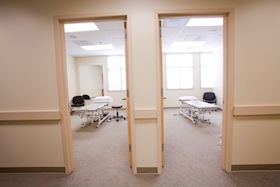Anterior Knee Pain, also known as “runner’s knee,” is the second most common reason for joint pain related physical therapy office visits. Patients with anterior knee pain complain of a dull ache at the front of the knee that feels like it’s coming from behind the patella (kneecap). Patients feel pain most strongly after sitting for a long time with their knees bent, as in a long meeting or at the movies, and when walking downstairs or bending down into a crouching or squatting position. In almost all cases, anterior knee pain can be relieved temporarily by simply straightening the leg. Untreated anterior knee pain is often severe enough to limit knee function, requiring sufferers to discontinue sports activities, avoid stairs, and seek out seating that allows frequent full leg extension.
The exact cause of anterior knee pain is not known, and the condition is considered difficult to treat. Most interventions for anterior knee pain are based on one or the other of two popular theories: “chondromalacia” of the cartilage behind the patella, and “malalignment” between the patella and femur.
Chondromalacia in the context of anterior knee pain refers to softening and degradation of cartilage behind the patella. Chondromalacia is so commonly considered the cause of anterior knee pain that the word is often used incorrectly as a synonym for anterior knee pain.
Cartilage behind the patella is thought to allow the patella and the end of the femur to slide smoothly relative to each other when the knee joint is in motion. Chondromalacia theory says that anterior knee pain occurs when the cartilage is softened or degraded. Chondromalacia is treated by surgery aimed at encouraging new cartilage to grow inside the knee joint or by separating intact cartilage from its original location and moving it to sites where the surgeon believes it will be more useful.
Surgery to correct chondromalacia has not been shown in rigorously designed, statistically valid studies to provide long-term relief from anterior knee pain. This lack of effect is consistent with what we know about joint cartilage: joint cartilage does not have nerve endings and can therefore not be a source of pain. The absence of pain receptors in knee cartilage was confirmed in an unusual experiment carried out on orthopedic surgeon Scott Dye, MD, who reported no sensation during direct probing, without anesthesia, of the cartilage behind his patella.
The presence or absence of chondromalacia does not predict whether someone does or does not have anterior knee pain. Many individuals with advanced chondromalacia do not have anterior knee pain, and many individuals with anterior knee pain do not have chondromalacia.
Malalignment theory proposes that the patella is somehow crooked or is located too far to one side or the other of the knee, causing excessive friction and pain. A number of therapies aimed at correcting malalignment have been developed, including:
- using tape applied to the skin to try to hold the patella in a “medial glide” position
- specific muscle training exercises aimed at changing the position of the patella
- “lateral release” surgery to change the position of the patella
None of the non-surgical treatments for patellar malalignment have been shown to change the position of the patella for any clinically meaningful duration of time. Therefore, it has been difficult to detect a statistical correlation between malalignment and anterior knee pain. In addition, none of the non-surgical or surgical treatments based on correcting malalignment have been shown statistically to provide long-term relief of anterior knee pain.
Like chondromalacia, patella alignment or malalignment does not predict whether an individual will experience anterior knee pain. Chondromalacia theory and malalignment theory are also similar in that they are both based on observations made when the knee is not moving.
At Physical Therapy of Los Gatos, we view the knee as a dynamic process, and we believe that anterior knee pain must be evaluated while the knee is in motion.
Our approach to understanding and treating anterior knee pain is influenced by the work of Bennet and Stauber, who in 1986 noticed that, in individuals with anterior knee pain, the amount of torque produced around the knee joint by the quadriceps muscles during dynamic, eccentric exercise (when the quadriceps muscles are lengthening to allow the knee to bend) was not normal in its distribution around the axis of rotation of knees affected by anterior knee pain. Contrary to the differences normally observed between eccentric and concentric muscle strength, torque measured around affected knees was less than torque measured around the same knees during concentric exercise. Bennet and Stauber also found that specific exercises could restore eccentric torque and torque distribution to normal, and when that was accomplished, anterior knee pain went away.
Analyzing the relative torque-producing capabilities of the quadriceps muscles during eccentric and concentric exercise is a critical aspect of our approach to evaluating patients with anterior knee pain. In our experience, re-defining the eccentric and concentric torque profiles of the quadriceps can be readily accomplished by a motivated patient using specific exercises that emphasize eccentric muscle strength. This approach provides long-term relief from anterior knee pain and allows our patients to return to sports and other activities requiring normal knee function.

{ 1 trackback }
Comments on this entry are closed.